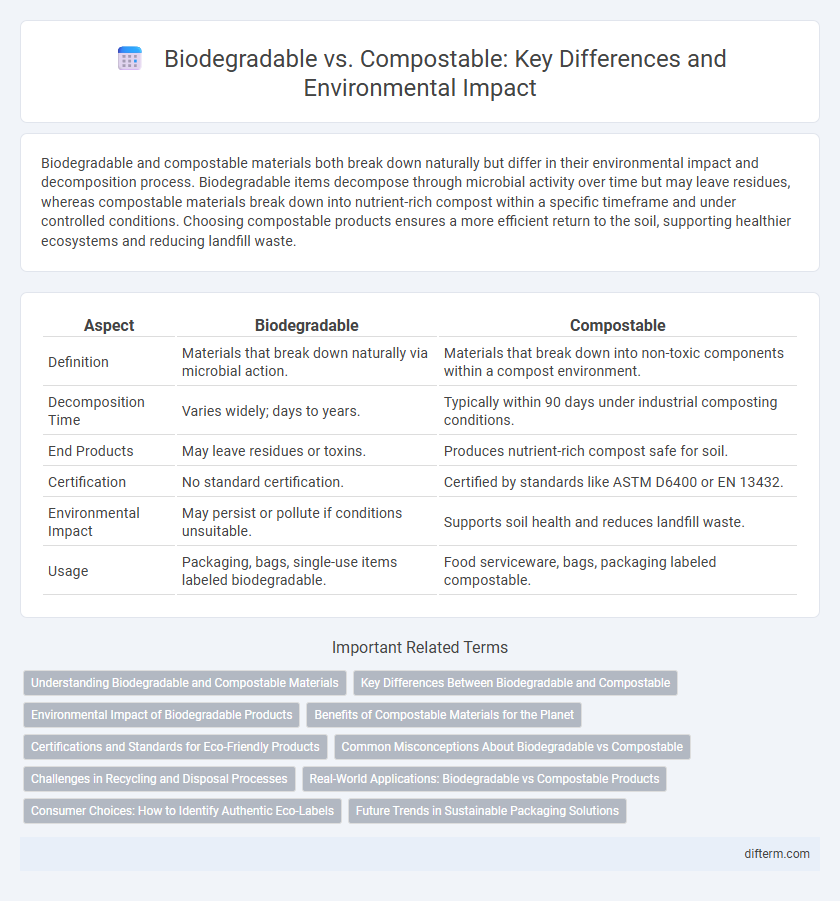Biodegradable and compostable materials both break down naturally but differ in their environmental impact and decomposition process. Biodegradable items decompose through microbial activity over time but may leave residues, whereas compostable materials break down into nutrient-rich compost within a specific timeframe and under controlled conditions. Choosing compostable products ensures a more efficient return to the soil, supporting healthier ecosystems and reducing landfill waste.
Table of Comparison
| Aspect | Biodegradable | Compostable |
|---|---|---|
| Definition | Materials that break down naturally via microbial action. | Materials that break down into non-toxic components within a compost environment. |
| Decomposition Time | Varies widely; days to years. | Typically within 90 days under industrial composting conditions. |
| End Products | May leave residues or toxins. | Produces nutrient-rich compost safe for soil. |
| Certification | No standard certification. | Certified by standards like ASTM D6400 or EN 13432. |
| Environmental Impact | May persist or pollute if conditions unsuitable. | Supports soil health and reduces landfill waste. |
| Usage | Packaging, bags, single-use items labeled biodegradable. | Food serviceware, bags, packaging labeled compostable. |
Understanding Biodegradable and Compostable Materials
Biodegradable materials break down naturally through microbial activity over time, but their decomposition rates and environmental impact can vary widely based on conditions. Compostable materials decompose fully into nutrient-rich compost within a specific timeframe under controlled industrial composting environments, leaving no toxic residue. Understanding the differences between biodegradable and compostable materials is crucial for effective waste management and reducing environmental pollution.
Key Differences Between Biodegradable and Compostable
Biodegradable materials break down naturally through the action of microorganisms but do not guarantee a specific timeframe or environmental benefit. Compostable materials decompose into nutrient-rich compost within a defined period under controlled conditions, meeting standards like ASTM D6400 or EN 13432. The key difference lies in compostable products requiring industrial composting settings for full decomposition, whereas biodegradable items may degrade in various environments without producing beneficial byproducts.
Environmental Impact of Biodegradable Products
Biodegradable products break down naturally through microbial activity, reducing landfill accumulation and lowering environmental pollution compared to conventional plastics. However, their decomposition rate varies widely depending on environmental conditions such as temperature, moisture, and microbial presence. Unlike compostable products, biodegradable materials may not fully degrade into non-toxic components, potentially leaving microplastics that persist in ecosystems.
Benefits of Compostable Materials for the Planet
Compostable materials break down into nutrient-rich organic matter that enhances soil health and supports plant growth, reducing the need for chemical fertilizers. Unlike biodegradable materials, compostable products fully degrade in controlled conditions without releasing harmful residues, minimizing environmental pollution. Their use contributes to lowering greenhouse gas emissions by diverting waste from landfills and promoting circular waste management practices.
Certifications and Standards for Eco-Friendly Products
Biodegradable products break down naturally through microbial activity but may require specific conditions, while compostable products must meet stringent standards like ASTM D6400 or EN 13432, ensuring complete decomposition into non-toxic components within a defined timeframe. Certifications such as the BPI (Biodegradable Products Institute) and the OK Compost label guarantee that materials comply with verified environmental criteria for industrial or home composting. Selecting certified eco-friendly products ensures adherence to internationally recognized standards, promoting sustainable waste management and reducing environmental impact.
Common Misconceptions About Biodegradable vs Compostable
Biodegradable materials break down naturally through microbial activity but lack a specific timeframe or environmental conditions for complete decomposition. Compostable products are a subset of biodegradable items guaranteed to decompose into nutrient-rich compost within a set period under controlled conditions, typically industrial composting facilities. Misconceptions arise when consumers assume all biodegradable items are compostable, leading to improper disposal and reduced environmental benefits.
Challenges in Recycling and Disposal Processes
Biodegradable materials often require specific environmental conditions to break down effectively, which can complicate their recycling and disposal in standard waste management systems. Compostable products must be processed in industrial composting facilities to degrade properly, yet limited access to such facilities poses significant challenges. Misclassification of biodegradable and compostable items leads to contamination in recycling streams, reducing overall efficiency and increasing operational costs.
Real-World Applications: Biodegradable vs Compostable Products
Biodegradable products break down naturally through microbial activity over variable timeframes, often requiring specific environmental conditions, whereas compostable products decompose into nutrient-rich compost within a defined period under industrial or home composting setups. Real-world applications of biodegradable materials include packaging and single-use plastics that degrade in soil or marine environments, while compostable products are ideal for food waste bags and agricultural films designed for safe integration into composting systems. Choosing between biodegradable and compostable materials depends on disposal infrastructure and environmental goals, emphasizing the importance of clear labeling and consumer education to reduce landfill waste and promote sustainability.
Consumer Choices: How to Identify Authentic Eco-Labels
Consumers can identify authentic eco-labels by looking for certifications from recognized organizations such as the Biodegradable Products Institute (BPI) or the Composting Council Research and Education Foundation (CCREF). Biodegradable products break down naturally but may leave residues, while compostable items fully decompose into nutrient-rich soil within standard composting conditions. Understanding these distinctions helps consumers make informed eco-friendly choices that align with verified environmental standards.
Future Trends in Sustainable Packaging Solutions
Biodegradable packaging materials, which break down naturally through microbial activity within months, are increasingly favored for reducing landfill waste. Compostable packaging, designed to decompose into nutrient-rich compost within specific industrial or home composting systems, offers a closed-loop solution to organic waste management. Future trends emphasize innovative blends of bio-based polymers and advancements in enzymatic degradation to enhance the efficiency and scalability of sustainable packaging solutions.
biodegradable vs compostable Infographic

 difterm.com
difterm.com